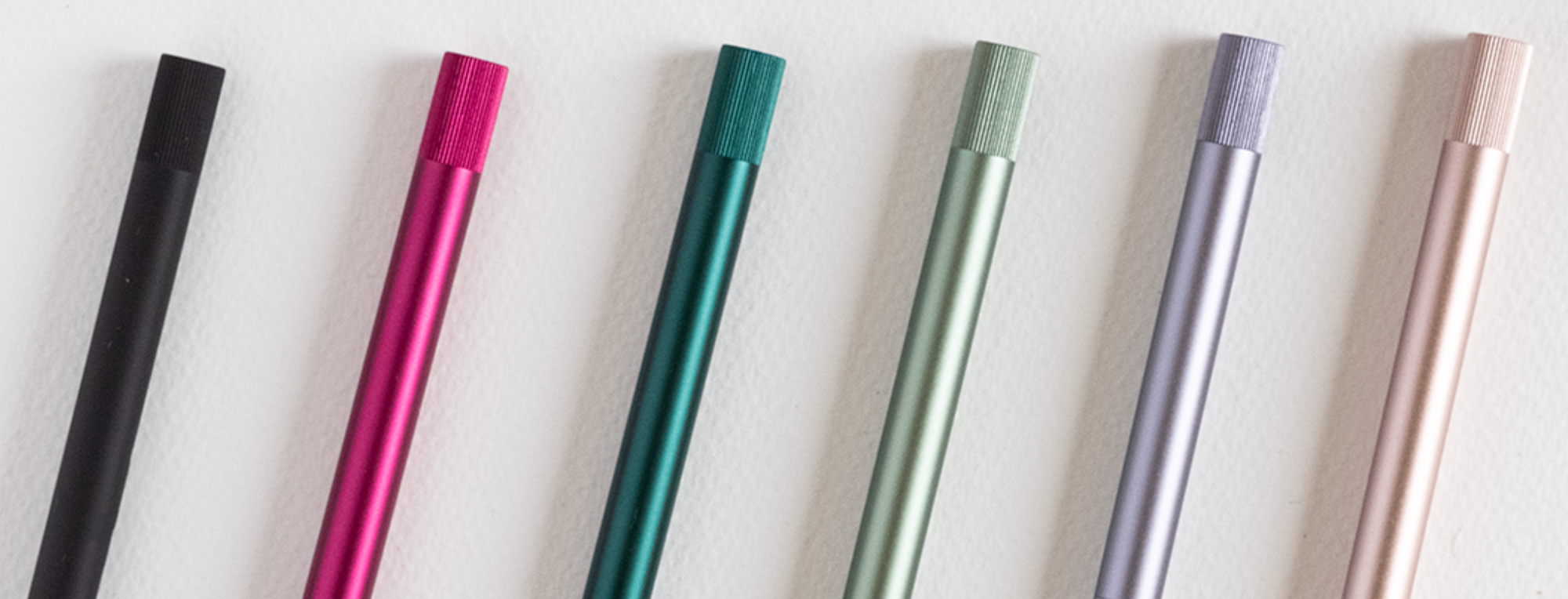The Lumos
A brief guide to get you started with your new pen.

About the Lumos
The Lumos Pro Duo is designed for versatility, offering two nibs in one sleek pen body. This means you can easily switch between ink colours or nib sizes. The Lumos Pro Single has just one nib but features a reservoir that’s twice the size of the Duo, giving you longer writing sessions between refills.
Tom designed the Lumos to tackle the frustrations of traditional refillable pens, which often create unnecessary waste or tie you to specific ink systems. Unlike other pens, the Lumos offers versatility, durability, and the freedom to use a wide range of inks, making it the ultimate tool for creatives who value quality and sustainability.
Precision-crafted anodised aluminium – the same material used in aerospace engineering! Anodising makes the pen durable, with a finish tough enough to stand the test of time and an array of stunning colour options.
Lumos Pro Single/Duo
- Length capped – 155mm
- Length uncapped – 145mm
- Pen barrel diameter – 10mm
- Weight – 20g
Lumos Mini
- Length capped – 85mm
- Length uncapped – 75mm
- Pen barrel diameter – 10mm
- Weight – 10g
Absolutely! The Lumos is travel-friendly and perfectly safe for aeroplane journeys. Since it contains no liquids, it's perfectly safe to pack in your hand luggage. However, we don’t recommend storing it in checked luggage.
Of course! The ink dries quickly, so there’s no risk of smudging for left-handed writers.
All About Inks
The Lumos works best with dye-based inks, which flow smoothly through its reservoir and nibs. Avoid inks with shimmer particles or heavy binders like shellac or acrylic.
Which inks work? Fountain pen inks (all of which are dye-based) that don’t contain particles (such as shimmer inks) or binders (like acrylic or shellac).
Exception to the rule? We sell a couple of splendid waterproof pigment inks: Sailor Kiwa-guro and Platinum Carbon.
It’s simple:
- Unscrew the tip holder to access the reservoir.
- Dip the reservoir into your ink of choice and let the capillary action draw the ink in.
- Reassemble the pen, and you’re ready to write!
We’ve also created a helpful video guide –find it here.
There are two ways to switch ink colours:
- Rinse the nib and reservoir under warm running water, dry thoroughly, and refill with your new ink.
- Swap out the tip and reservoir entirely and store the old ones in a ziplock bag or container.
With proper care, a reservoir can last indefinitely if you stick to the same ink.
If you frequently clean and switch inks, you may get around 4-5 washes before capillary action starts to diminish. Don’t worry – we sell replacement reservoirs for when you need them.
All about Tips
The writing tip has a rounded shape, giving a smoother feel on the page but less control over line weight. The fineliner tip, on the other hand, is perfect for precise, consistent lines.
Tip sizes can vary by manufacturer, but every Lumos comes with a full creative tip set so you can find the one that suits your style best.
Our tips are crafted in Japan and built to outlast many of their competitors. Longevity depends on factors like:
- Paper smoothness (smoother paper reduces wear).
- Tip size (smaller tips experience more pressure and may wear faster).
- Writing style (heavy pressure or techniques like pointillism can shorten lifespan).
- Ink choice (free-flowing inks reduce friction).
Great news though, replacement tips are affordable and environmentally friendly.
You can find our full tip collection and multipacks of your favourites here.
Fineliner and writing tips are inserted from inside the tip holder, not through the hole in the top. The brush, chisel and felt tips can be inserted from the top.
The silicone grip included with your Lumos makes changing tips a breeze! Simply use it to grab the tip without any mess.
Soak them in warm soapy water or our Nib Cleaning Solution for 30 minutes, then rinse thoroughly. There may be a small amount of residual ink, but it will clear out after a few strokes with your new ink.
CARING FOR YOUR LUMOS
Regular cleaning with warm soapy water will keep your Lumos in great condition. Be sure to dry all parts thoroughly and check for ink in the threaded sections before reassembling. A touch of silicone grease on the threads will help maintain a smooth seal.
Store spare tips and reservoirs in our tip and reservoir containers or ziplock bag to prevent them from drying out.
We recommend storing your Lumos horizontally in a cool, dry place to keep it in tip-top condition.
TROUBLESHOOTING
If the ink has dried, refill the reservoir with the same ink or dip the nib briefly in water to get it flowing again.
The reservoir may not be fully loaded. Try dipping it in ink again for 10–20 seconds and ensure it’s securely reinserted into the pen.
Use the silicone grip included with your Lumos for better traction when unscrewing the tip holder – you can find a video showing how to do this here. For smooth operation in the future, apply a tiny amount of silicone grease to the threads.
